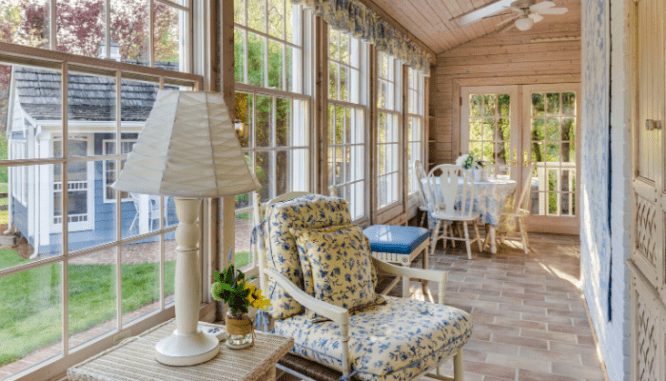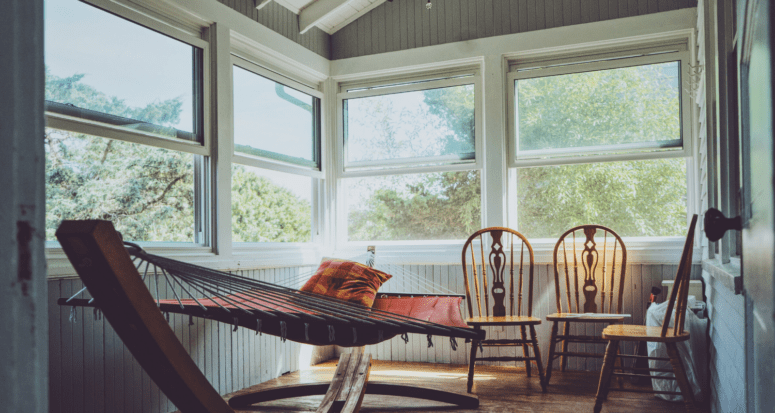Four-Season Sanctuary or Simple Solarium? How to Choose the Right Sunroom for Your Home
- Published on
- 4 min read
-
 Alison Hunter Contributing AuthorClose
Alison Hunter Contributing AuthorClose Alison Hunter Contributing Author
Alison Hunter Contributing AuthorIn addition to real estate, Bay Area native and quasi-techy Alison Hunter also writes about the intersection of art, culture, and technology.
A comfy chair. A good book. The sun warms your face as you gaze through crystal clear, low-emissivity, argon-padded, double-glazed windows. You watch the wind dance in the treetops nearby; you sink into your surroundings. A sunroom is a whole room dedicated to making moments like this happen.
Or perhaps your sunroom dream is less about sipping tea and more about cans of beer and cut-throat poker matches. Maybe it’s a summertime dining room, or a guest room.
Mini-gym? Man-cave? She-shed? No matter how you use it, a sunroom can add quality to your life and value to your home.
But what do you need to know before you add a sunroom to your home? Is this a cheap, DIY no-brainer or a bank-breaking project for pros only?
This article will shine the light on pros and cons, illuminate your path, spotlight the benefits, and bring helpful information to the sun(room) so you don’t get burned.

A whole room for sun — what?!
A sunroom is exactly as advertised: a whole room, just for sun.
Historically, when luxuries like electric lights and heat were unfathomable, people had to leverage what was available to them: the light and heat from the giant fireball in the sky. The modern sunroom is a kind of throwback luxury — much like camping, we still want to enjoy the out-of-doors…but we don’t want to be bothered by the inconveniences we built habitats to avoid, so we create a half-way point.
A drop of golden sun
If we look way, way back in human history, the first sunroom was created in around 6000 BC by adding a window to a dwelling, thus bringing the sun into a room. Ta-daa!
Necessity being the mother of invention, it’s not hard to imagine why someone would dream up a way to be both outside (where the sun lives) and inside (where bugs and other predators don’t) at the same time. For readers interested in a deep-dive on the history of sunrooms, check out A Golden Thread — 2500 Years of Solar Architecture and Technology by Ken Butti and John Perin.
Florida or Arizona?
The modern sunroom is a space for leisure. It has many forms and many names: three-season sunroom, four-season sunroom, covered patio, sun porch, screen room, solarium, or conservatoire.
In Florida, they are known as Florida rooms, but top-selling Arizona agent Merrill Jencks reports that when a sunroom is built in Arizona, it’s known as an Arizona room. Go figure!
Another unique feature of Arizona sunrooms is that they are built to optimize for shade rather than for sun. They are decked out with heavy-duty window treatments and are often tapped in to the house’s HVAC system to make them usable year-round. (More on the four-season sunrooms native to extreme climates later.)
Regardless of where you live, a sunroom built for your climate gives you the best of both worlds: the great outdoors and the wonderful, climate-controlled indoors.
What makes a sunroom, a sunroom?
A sunroom is an attachment to a home, sometimes built during the original construction, but often added on afterward. They can be prefabricated or custom built.
Clearly, glass is the main element of a sunroom. We’re talking windows, windows, sometimes a skylight, and more windows. Usually, three of the four walls are glass, and skylights often let in light from above. Simple sunrooms may not have windows that open, while more high-end sunrooms tend to be built for year-round comfort.
The difference between three- and four-season sunrooms
Three-season sunrooms generally do not include certain features found in the rest of the house. Though electricity is common, three-season sunrooms are typically not insulated and don’t have heating or AC.
While they may not be robustly outfitted for extreme temperatures, they do usually have a way to get hot air out: windows open wide on adjacent walls to accommodate a cross-breeze; skylights open to let heat rise up, up, and away; and ceiling fans keep air moving. Window treatments also work for climate control in three-season sunrooms.
A four-season sunroom is more like a “real” room than any other type of sunroom. What makes it “real” is the attention to climate control. These sunrooms have insulated “knee walls” — basically just enough wall to create a foundation to run all the infrastructure through and cover the load-bearing needs for heat, AC, and high-end windows. Four-season sunrooms are usually made out of sturdier materials; more on that later.

OK, I want a sunroom. What next?
DIY or hire a guy (or gal)?
Is erecting three glass walls an easy project? Well… it depends. Unless you’re a seasoned pro, it’s best to budget for a good contractor, even if you’re going to use a prefabricated model. Jencks says it is imperative to get city permits before you build, which is rigmarole an experienced, licensed contractor can easily handle. Unpermitted additions become big problems when homes go to market. Although it’s unlikely a city official will bang on your door and make you tear it down, an unpermitted addition can make or break a sale.
Most importantly, you must have the permit in place to claim the added square footage to your listing. This goes for prefabricated sunrooms and custom builds alike: no matter what you build, you have to pull a permit. Period. You can also expect a bit of a bump in your home insurance and property taxes, so be sure to budget this in as well.
Where should I put my sunroom?
This decision should be unique to your house, because there’s no right answer for every single home.
The south side of your house likely gets the most sun if you live in the Northern Hemisphere. But do you live in a very warm state and have a gorgeous view on the shady, north side of your house? Then that’s a great spot for a sunroom! Do you love to watch the sun rise in the morning? East-facing sunroom for you, and a west-facing sunroom for your friend who loves to watch the sun set.
The point is, there are very few rules about where to add your sunroom. It will all depend on your preferences, the specifics of your home, and the layout of your property.
Keep in mind: your preferences may have to take a back seat to the structural and practical realities of your property. While the foundation necessary to support a sunroom is not as hardy as the rest of a home, it does require a perfectly executed slab of concrete, which is not easy to pull off if your dream location is on a slope. It’s doable, but extensive site preparation will likely add one to several zeros to your final bill.
Construction materials
If the construction materials of a sunroom read like the ingredients on a box of cereal, the first on the list would be glass. It’s glass galore, and the infrastructure to hold it all up.
Custom-built sunrooms tend to be made of traditional building materials (think wood and nails), while prefabricated units are usually made from vinyl or aluminum. Ideally, the exterior of a sunroom matches the exterior of the house to which it is attached, and getting this just right can be tricky. Most four-season sunrooms are “stick built” (again, think wood and nails), and a qualified contractor will keep your home and its sunny addition in perfect visual harmony.
Window materials
Did we mention there are a lot of windows in a sunroom? Luckily, we’ve moved far beyond the days of slabs of minerals and, in most cases, even single-paned windows.
Most sunroom windows are double-glazed: two panes of glass sandwiched into a single frame. Low-emissivity coatings are applied to boost the insulation factor by blocking thermal energy (heat), and in some cases, the space between the panes is filled with argon gas. Twin-wall polycarbonate, a highly-durable extruded plastic, is a popular material choice for letting the sun shine in from above.

What’s the damage?
People who hope to live in (partially) glass houses can expect to pay between $5,000 and $80,000 for their new addition. The lower end of that spread represents a prefab kit and does not include labor. The upper end is typical for an all bells-and-whistles four-season sunroom — but as with all bespoke creations, the sky’s the limit.
So what’s the low-down on the ROI? Will you recoup what you spend?
In a word: no. You can expect about half (49% to be exact) of what you spend to add a sunroom to your home to come back to you if you sell.
But think back to that imaginary poker game, or the summertime meals shared with your family with the sunroom windows open to a cool breeze. Jencks says the cost/benefit analysis of adding a sunroom to your home requires the same thought process as adding a swimming pool to your backyard: if you love it and use it all the time, then the joy of having it will offset whatever you don’t make back if you sell.
So maybe for you, “home” is to “investment” as “Thanksgiving dinner” is to “nutrients”: an insufficient way to describe a deeply significant and beautiful thing. If your home sweet home is made a bit sweeter by sun, can you really put a price on that?
Header Image Source: (Ostap Senyuk / Unsplash)
